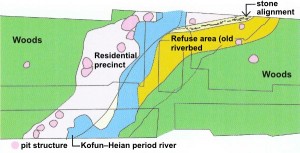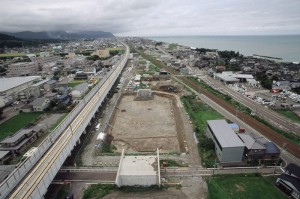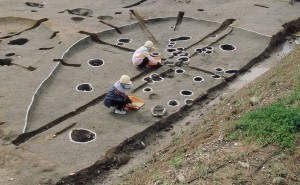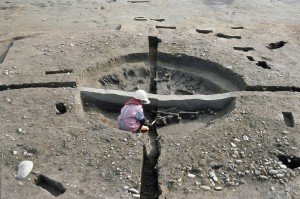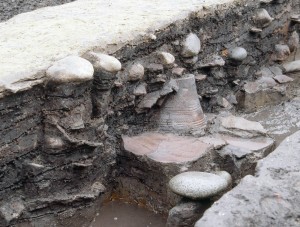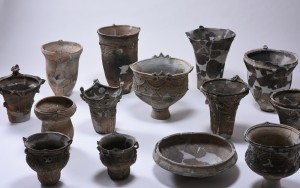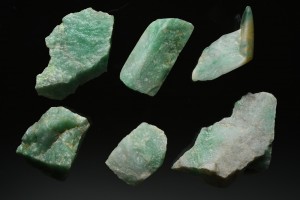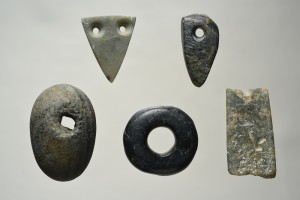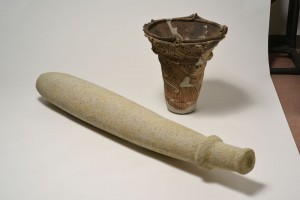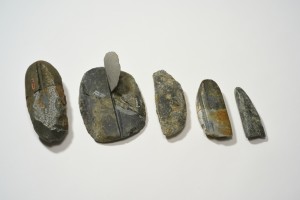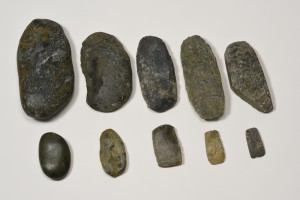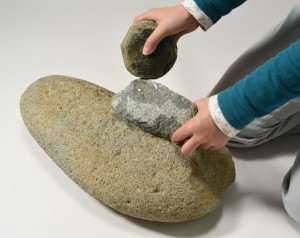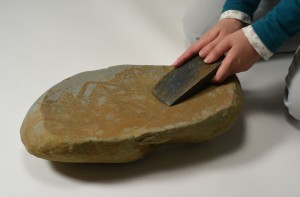Stone alignment and refuse area
The stone alignment was built following the points of topographic change, dividing the residential precinct atop a natural levee (left) and the refuse area (right) which utilized an old riverbed.

Settlement structure of the Rokutanda Minami Site
Adapted from Hakkutsu sareta Nihon rettō 2016 [Excavations in the Japanese Archipelago, 2016] (Bunkachō [Agency for Cultural Affairs], ed., Kyodo News, 2016).
Panorama of the site (from the east)
About 200 m distant from the Japan Sea. With the Chōjagahara Historic Site 4 km to the southwest, and the Teraji Historic Site 8 km to the west, a number of Jōmon Period settlement sites are distributed across the city of Itoigawa.
Residential precinct
Multiple pit structures were built atop a natural levee. The area is about 40 m north–south by 10 m east–west.
Largest pit structure in the lower layer The diameter of the long axis is 10 m or greater. There were two rectangular stone-lined hearths built, each enclosed with stones arranged in a square shape.
Scorched building covered by a flood layer
This pit structure had filled in halfway after burning when it was buried by a flood-borne layer. Dirt dug from within the pit had been piled to form a dike around the circumference. Rafters forming the roof remained in a radial pattern, and as there was scorched earth above it is inferred to have had a sod roof. Diameter of the pit portion was 3.5 m.
Refuse area
Scene of the excavation in progress
Excavation was conducted from 2006 to 2013.
Buried pot feature This is thought to have been a burial facility for an infant. More than 10 such features were confirmed, with the majority found in the refuse area.
Cross section of the soil strata of the refuse area Beneath a layer of flood-borne material, discarded pottery, stone tools, and leftover food were deposited in large volumes.
Stone alignment
The length of the stone alignment confirmed through excavation was approximately 38 m, but it continued to extend past the excavation area. While it can be described as a straight line as a whole, it contained gaps as well as segments of regulated alignment. The latter all appear to describe gentle arc shapes. Almost no features were detected in the area extending about 2 m to the right of the stone alignment.
Closeup of the stone alignment The long axes of the stones were laid closely matching the direction of the stone alignment. From an examination of the soil strata, it is inferred to have been built at the start of the period of construction of the settlement. The average weight of the stones was 24 kg, with the largest at 88 kg. The material for the most part is locally produced porphyrite.
A large volume of pottery and stone tools packed beneath the flood layers
Various shapes of Jōmon pottery
Pottery designs in this region are characteristically fluid and lively, made in raised curvilinear patterns by pasting coils of clay, and applied over the entire vessel surface. An item showing influence from the Tōhoku region is also included (★). Apart from the shallow bowl at center, all were used for boiling food. The item at bottom right is 31.9 cm tall.
Jade source stones
Because jade is hard, most of these items were used as hammer stones. The manufacture of jade beads in quantity began from around the latter half of the Middle Jōmon. The item at left is 6.6 cm long.
Stone pendants
On the upper row, the item at left is fashioned in a shark tooth shape, and the one at right after a tusk. The item at upper left is 2.8 cm long and 2.2 cm wide.
Stone rod
An extremely large item, 1 m in length. Made of coarse-grained basalt.
Clay figurines
The item at upper left consists of a head, chest, and arm portions fitted together. The length is 7.4 cm, and the width is 8.3 cm.
Applying abrasion with a stone saw.
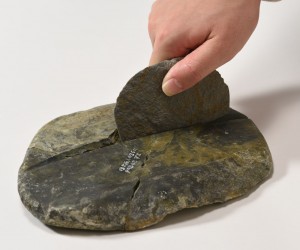
Process of manufacture of polished stone axes with the abrasion technique
The abrasion technique is a method for making two or more stone axes from a single stone. A flat stone is cut through with abrasion, and a finished item (far right) produced with hammering and polishing applied mainly to the cut surface. Item at far left is 20.8 cm long.
Process of polished stone axe production (Upper row: large items; lower row: small items) Flat stones (far left) gathered from the seashore are turned into finished products (far right) through flaking, pecking, and polishing. Based on the condition of the material the process may be abandoned partway through, a tendency that is particularly strong with small items. Stones of tremolite are mostly used as the raw material. Item at upper left is 17.9 cm long.
Flaking and pecking are done with a hammer stone on top of an anvil stone.
A polished stone axe is ground on top of a flat sharpening stone.
Rokutanda Minami Site, Itoigawa City, Niigata Prefecture
Middle Jōmon period (approximately 4,500 years ago)
A settlement located on the marine coast
The Rokutanda Minami site is located approximately 200 m inland from the Japan Sea in the southwestern portion of Niigata prefecture, situated at an elevation of 3.5 to 4.5 m on an alluvial plain. As a result of an excavation preceding the construction of the Hokuriku Shinkansen and the Itoigawa Eastern Bypass, three occupation surfaces were found in the upper (Yayoi–Medieval), middle (middle portion of the Middle Jōmon), and lower (early to middle portions of the Middle Jōmon) strata. As flood deposits separated each of these occupation surfaces, those of the middle and lower strata were in good states of preservation. Both were Jōmon period settlements comprised of about 10 pit structures.
Even though approximately 1 m of deposit separated the middle and lower layers, they were chronologically continuous. The settlement of the lower layer, which was the best preserved, was restricted by the local topography and was built with multiple pit structures atop a long and narrow natural levee. To the east of this residential precinct a refuse area was found, where pottery, stone tools, and food remains had been discarded, together with a stone alignment that bounded it. Artifacts were almost entirely unseen to the west of the residential precinct and to the east of the refuse area, and from an analysis of the tree remains they are thought to have been densely grown woods composed of members of genuses such as camellia, maple, and Japanese walnut.
A base for exchange beyond the region
Pottery of the lower layer was found in a crushed state, but as conditions of preservation were good, much of it can be reconstructed. Although the site lies at the western edge of Niigata prefecture, the pottery belongs to the Hokuriku culture sphere spreading over Toyama prefecture to the west. This sphere includes the Shinano river basin in Nagano and central Niigata prefectures, where there is an admixture of pottery showing influence from the Tōhoku region.
Among the stone tools, polished stone axes and unfinished examples were by far the most plentiful, reaching more than 2,000 items in total. As several hundred examples of both hammer stones and sharpening stones used in their manufacture were also recovered, the site is thought to have been a settlement where stone axe manufacture was carried out in concentrated fashion. The majority of polished stone axes produced were probably supplied to various other areas. In addition, stone weights thought to have served as net sinkers for fishing were found in numbers. As a result of the analysis of the large volume of bone fragments found in the refuse area, there was a great variety including types of salmon, sea bream, and sharks.
In this manner, the outlines of a core settlement that prospered from stone axe making and fishing, and engaged in active exchange with various other areas, can be perceived. (Takahashi Yasuo and Takahashi Tamotsu)

